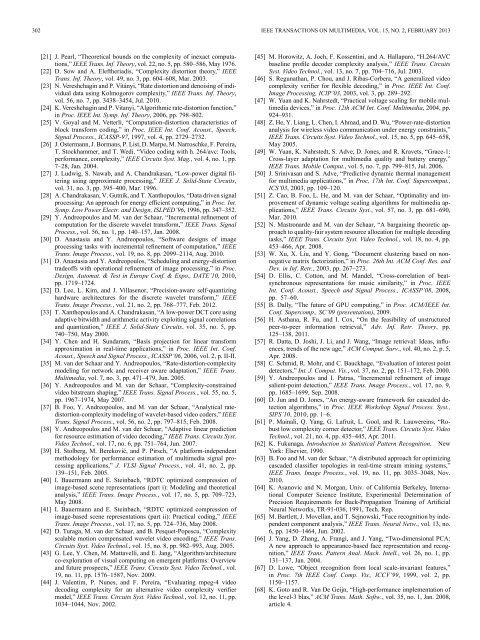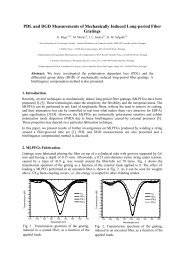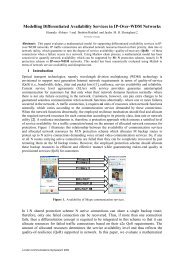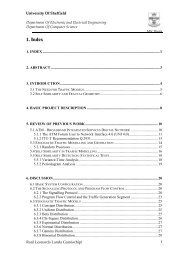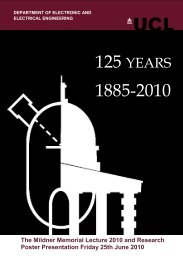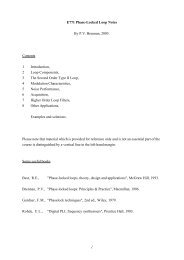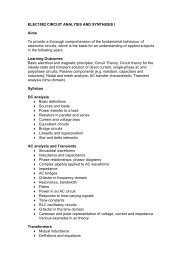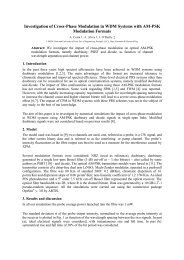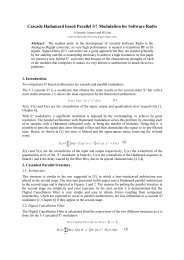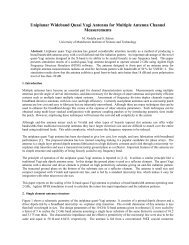Error Tolerant Multimedia Stream Processing: There's ... - IEEE Xplore
Error Tolerant Multimedia Stream Processing: There's ... - IEEE Xplore
Error Tolerant Multimedia Stream Processing: There's ... - IEEE Xplore
Create successful ePaper yourself
Turn your PDF publications into a flip-book with our unique Google optimized e-Paper software.
302 <strong>IEEE</strong> TRANSACTIONS ON MULTIMEDIA, VOL. 15, NO. 2, FEBRUARY 2013[21] J. Pearl, “Theoretical bounds on the complexity of inexact computations,”<strong>IEEE</strong> Trans. Inf. Theory, vol. 22, no. 5, pp. 580–586, May 1976.[22] D. Sow and A. Eleftheriadis, “Complexity distortion theory,” <strong>IEEE</strong>Trans. Inf. Theory, vol. 49, no. 3, pp. 604–608, Mar. 2003.[23] N. Vereshchagin and P. Vitányi, “Rate distortion and denoising of individualdata using Kolmogorov complexity,” <strong>IEEE</strong> Trans. Inf. Theory,vol. 56, no. 7, pp. 3438–3454, Jul. 2010.[24] K. Vereshchagin and P. Vitanyi, “Algorithmic rate-distortion function,”in Proc. <strong>IEEE</strong> Int. Symp. Inf. Theory, 2006, pp. 798–802.[25] V. Goyal and M. Vetterli, “Computation-distortion characteristics ofblock transform coding,” in Proc. <strong>IEEE</strong> Int. Conf. Acoust., Speech,Signal Process., ICASSP-97, 1997, vol. 4, pp. 2729–2732.[26] J. Ostermann, J. Bormans, P. List,D.Marpe,M.Narroschke,F.Pereira,T. Stockhammer, and T. Wedi, “Video coding with h. 264/avc: Tools,performance, complexity,” <strong>IEEE</strong> Circuits Syst. Mag., vol. 4, no. 1, pp.7–28, Jan. 2004.[27] J. Ludwig, S. Nawab, and A. Chandrakasan, “Low-power digital filteringusing approximate processing,” <strong>IEEE</strong> J. Solid-State Circuits,vol. 31, no. 3, pp. 395–400, Mar. 1996.[28] A. Chandrakasan, V. Gutnik, and T. Xanthopoulos, “Data driven signalprocessing: An approach for energy efficient computing,” in Proc. Int.Symp. Low Power Electr. and Design, ISLPED’96, 1996, pp. 347–352.[29] Y. Andreopoulos and M. van der Schaar, “Incremental refinement ofcomputation for the discrete wavelet transform,” <strong>IEEE</strong> Trans. SignalProcess., vol. 56, no. 1, pp. 140–157, Jan. 2008.[30] D. Anastasia and Y. Andreopoulos, “Software designs of imageprocessing tasks with incremental refinement of computation,” <strong>IEEE</strong>Trans. Image Process., vol. 19, no. 8, pp. 2099–2114, Aug. 2010.[31] D. Anastasia and Y. Andreopoulos, “Scheduling and energy-distortiontradeoffs with operational refinement of image processing,” in Proc.Design, Automat. & Test in Europe Conf. & Expo., DATE’10, 2010,pp. 1719–1724.[32] D. Lee, L. Kim, and J. Villasenor, “Precision-aware self-quantizinghardware architectures for the discrete wavelet transform,” <strong>IEEE</strong>Trans. Image Process., vol. 21, no. 2, pp. 768–777, Feb. 2012.[33] T. Xanthopoulos and A. Chandrakasan, “A low-power DCT core usingadaptive bitwidth and arithmetic activity exploiting signal correlationsand quantization,” <strong>IEEE</strong> J. Solid-State Circuits, vol.35,no.5,pp.740–750, May 2000.[34] Y. Chen and H. Sundaram, “Basis projection for linear transformapproximation in real-time applications,” in Proc. <strong>IEEE</strong> Int. Conf.Acoust., Speech and Signal Process., ICASSP’06, 2006, vol. 2, p. II-II.[35] M. van der Schaar and Y. Andreopoulos, “Rate-distortion-complexitymodeling for network and receiver aware adaptation,” <strong>IEEE</strong> Trans.<strong>Multimedia</strong>, vol. 7, no. 3, pp. 471–479, Jun. 2005.[36] Y. Andreopoulos and M. van der Schaar, “Complexity-constrainedvideo bitstream shaping,” <strong>IEEE</strong> Trans. Signal Process., vol. 55, no. 5,pp. 1967–1974, May 2007.[37] B. Foo, Y. Andreopoulos, and M. van der Schaar, “Analytical ratedistortion-complexitymodeling of wavelet-based video coders,” <strong>IEEE</strong>Trans. Signal Process., vol. 56, no. 2, pp. 797–815, Feb. 2008.[38] Y. Andreopoulos and M. van der Schaar, “Adaptive linear predictionfor resource estimation of video decoding,” <strong>IEEE</strong> Trans. Circuits Syst.Video Technol., vol. 17, no. 6, pp. 751–764, Jun. 2007.[39] H. Stolberg, M. Bereković, and P. Pirsch, “A platform-independentmethodology for performance estimation of multimedia signal processingapplications,” J. VLSI Signal Process., vol. 41, no. 2, pp.139–151, Feb. 2005.[40] I. Bauermann and E. Steinbach, “RDTC optimized compression ofimage-based scene representations (part i): Modeling and theoreticalanalysis,” <strong>IEEE</strong> Trans. Image Process., vol. 17, no. 5, pp. 709–723,May 2008.[41] I. Bauermann and E. Steinbach, “RDTC optimized compression ofimage-based scene representations (part ii): Practical coding,” <strong>IEEE</strong>Trans. Image Process., vol. 17, no. 5, pp. 724–736, May 2008.[42] D. Turaga, M. van der Schaar, and B. Pesquet-Popescu, “Complexityscalable motion compensated wavelet video encoding,” <strong>IEEE</strong> Trans.Circuits Syst. Video Technol., vol. 15, no. 8, pp. 982–993, Aug. 2005.[43] G. Lee, Y. Chen, M. Mattavelli, and E. Jang, “Algorithm/architectureco-exploration of visual computing on emergent platforms: Overviewand future prospects,” <strong>IEEE</strong> Trans. Circuits Syst. Video Technol., vol.19, no. 11, pp. 1576–1587, Nov. 2009.[44] J. Valentim, P. Nunes, and F. Pereira, “Evaluating mpeg-4 videodecoding complexity for an alternative video complexity verifiermodel,” <strong>IEEE</strong> Trans. Circuits Syst. Video Technol., vol. 12, no. 11, pp.1034–1044, Nov. 2002.[45] M. Horowitz, A. Joch, F. Kossentini, and A. Hallapuro, “H.264/AVCbaseline profile decoder complexity analysis,” <strong>IEEE</strong> Trans. CircuitsSyst. Video Technol., vol. 13, no. 7, pp. 704–716, Jul. 2003.[46] S. Regunathan, P. Chou, and J. Ribas-Corbera, “A generalized videocomplexity verifier for flexible decoding,” in Proc. <strong>IEEE</strong> Int. Conf.Image <strong>Processing</strong>, ICIP’03, 2003, vol. 3, pp. 289–292.[47] W. Yuan and K. Nahrstedt, “Practical voltage scaling for mobile multimediadevices,” in Proc. 12th ACM Int. Conf. <strong>Multimedia</strong>, 2004, pp.924–931.[48] Z. He, Y. Liang, L. Chen, I. Ahmad, and D. Wu, “Power-rate-distortionanalysis for wireless video communication under energy constraints,”<strong>IEEE</strong> Trans. Circuits Syst. Video Technol., vol. 15, no. 5, pp. 645–658,May 2005.[49] W. Yuan, K. Nahrstedt, S. Adve, D. Jones, and R. Kravets, “Grace-1:Cross-layer adaptation for multimedia quality and battery energy,”<strong>IEEE</strong> Trans. Mobile Comput., vol. 5, no. 7, pp. 799–815, Jul. 2006.[50] J. Srinivasan and S. Adve, “Predictive dynamic thermal managementfor multimedia applications,” in Proc, 17th Int. Conf. Supercomput.,ICS’03, 2003, pp. 109–120.[51] Z. Cao, B. Foo, L. He, and M. van der Schaar, “Optimality and improvementof dynamic voltage scaling algorithms for multimedia applications,”<strong>IEEE</strong> Trans. Circuits Syst., vol. 57, no. 3, pp. 681–690,Mar. 2010.[52] N. Mastronarde and M. van der Schaar, “A bargaining theoretic approachto quality-fair system resource allocation for multiple decodingtasks,” <strong>IEEE</strong> Trans. Circuits Syst. Video Technol., vol. 18, no. 4, pp.453–466, Apr. 2008.[53] W. Xu, X. Liu, and Y. Gong, “Document clustering based on nonnegativematrix factorization,” in Proc.26thInt.ACMConf.Res.andDev. in Inf. Retr., 2003, pp. 267–273.[54] D. Ellis, C. Cotton, and M. Mandel, “Cross-correlation of beatsynchronousrepresentations for music similarity,” in Proc. <strong>IEEE</strong>Int. Conf. Acoust., Speech and Signal Process., ICASSP’08, 2008,pp. 57–60.[55] B. Dally, “The future of GPU computing,” in Proc. ACM/<strong>IEEE</strong> Int.Conf. Supercomp., SC’09 (presentation), 2009.[56] H. Asthana, R. Fu, and I. Cox, “On the feasibility of unstructuredpeer-to-peer information retrieval,” Adv. Inf. Retr. Theory, pp.125–138, 2011.[57] R. Datta, D. Joshi, J. Li, and J. Wang, “Image retrieval: Ideas, influences,trends of the new age,” ACM Comput. Surv.,vol.40,no.2,p.5,Apr. 2008.[58] C. Schmid, R. Mohr, and C. Bauckhage, “Evaluation of interest pointdetectors,” Int. J. Comput. Vis., vol. 37, no. 2, pp. 151–172, Feb. 2000.[59] Y. Andreopoulos and I. Patras, “Incremental refinement of imagesalient-point detection,” <strong>IEEE</strong> Trans. Image Process., vol. 17, no. 9,pp. 1685–1699, Sep. 2008.[60] D. Jun and D. Jones, “An energy-aware framework for cascaded detectionalgorithms,” in Proc. <strong>IEEE</strong> Workshop Signal Process. Syst.,SIPS’10, 2010, pp. 1–6.[61] P. Mainali, Q. Yang, G. Lafruit, L. Gool, and R. Lauwereins, “Robustlow complexity corner detector,” <strong>IEEE</strong> Trans. Circuits Syst. VideoTechnol., vol. 21, no. 4, pp. 435–445, Apr. 2011.[62] K. Fukunaga, Introduction to Statistical Pattern Recognition. NewYork: Elsevier, 1990.[63] B. Foo and M. van der Schaar, “A distributed approach for optimizingcascaded classifier topologies in real-time stream mining systems,”<strong>IEEE</strong> Trans. Image Process., vol. 19, no. 11, pp. 3035–3048, Nov.2010.[64] K. Asanovic and N. Morgan, Univ. of California Berkeley, InternationalComputer Science Institute, Experimental Determination ofPrecision Requirements for Back-Propagation Training of ArtificialNeural Networks, TR-91-036, 1991, Tech. Rep.[65] M. Bartlett, J. Movellan, and T. Sejnowski, “Face recognition by independentcomponent analysis,” <strong>IEEE</strong> Trans. Neural Netw., vol. 13, no.6, pp. 1450–1464, Jun. 2002.[66] J. Yang, D. Zhang, A. Frangi, and J. Yang, “Two-dimensional PCA:A new approach to appearance-based face representation and recognition,”<strong>IEEE</strong> Trans. Pattern Anal. Mach. Intell., vol. 26, no. 1, pp.131–137, Jan. 2004.[67] D. Lowe, “Object recognition from local scale-invariant features,”in Proc. 7th <strong>IEEE</strong> Conf. Comp. Vis., ICCV’99, 1999, vol. 2, pp.1150–1157.[68] K. Goto and R. Van De Geijn, “High-performance implementation ofthe level-3 blas,” ACM Trans. Math. Softw., vol. 35, no. 1, Jan. 2008,article 4.


